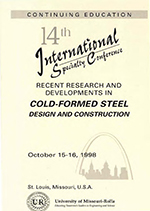Session Dates
15 Oct 1998
Abstract
A new design expression for web crippling of cold formed steel members has been developed. An extensive statistical analysis was performed using published test data from Canada, the United States, Sweden and France to develop new expressions for the web crippling strength of cold formed steel members under four different loading cases, i.e. (1) end one-flange loading (EOF), (2) interior one-flange loading (lOF), (3) end two-flange loading (ETF) and (4) interior two-flange loading (lTF). I-sections made of two channels connected back-to-back, Z-sections, channels and multiple web sections (decks) were considered. Comparisons were made with the web crippling expressions presented in the Canadian Standard for the design of cold formed steel structural members, CAN/CSA-S136-M89 (from here on referred to as S136) and with the 1991 LRFD edition of the American Iron and Steel Institute Specification (from here on referred to as AlSI). The web crippling strength depends primarily on the web thickness (t), the yield strength (Fy), the inside bend radius (r), the bearing length of the load (n), the flat dimension of the web measured in the plane of the web (h) and the angle between the plane of web and the plane of the bearing surface (θ). The definition of web depth, h, in both current design standards in Canada (SI36) and the United States (AlSI) was incorporated in the development of the new expressions. The new developed expression is nondimensional, therefore any consistent units of measurement can be used such as imperial or SI. Certain unnecessary complexities which now exist in both design standards have been removed to simplify the web crippling expressions. Eight simplified new expressions have been 'developed and one particular expression is recommended for design, which has already been adopted by the 1994 edition of S136.
Department(s)
Civil, Architectural and Environmental Engineering
Research Center/Lab(s)
Wei-Wen Yu Center for Cold-Formed Steel Structures
Meeting Name
14th International Specialty Conference on Cold-Formed Steel Structures
Publisher
University of Missouri--Rolla
Document Version
Final Version
Rights
© 1998 University of Missouri--Rolla, All rights reserved.
Document Type
Article - Conference proceedings
File Type
text
Language
English
Recommended Citation
Prabakaran, K. and Schuster, R. M., "Web Crippling of Cold Formed Steel Members" (1998). CCFSS Proceedings of International Specialty Conference on Cold-Formed Steel Structures (1971 - 2018). 2.
https://scholarsmine.mst.edu/isccss/14iccfsss/14iccfsss-session3/2
Web Crippling of Cold Formed Steel Members
A new design expression for web crippling of cold formed steel members has been developed. An extensive statistical analysis was performed using published test data from Canada, the United States, Sweden and France to develop new expressions for the web crippling strength of cold formed steel members under four different loading cases, i.e. (1) end one-flange loading (EOF), (2) interior one-flange loading (lOF), (3) end two-flange loading (ETF) and (4) interior two-flange loading (lTF). I-sections made of two channels connected back-to-back, Z-sections, channels and multiple web sections (decks) were considered. Comparisons were made with the web crippling expressions presented in the Canadian Standard for the design of cold formed steel structural members, CAN/CSA-S136-M89 (from here on referred to as S136) and with the 1991 LRFD edition of the American Iron and Steel Institute Specification (from here on referred to as AlSI). The web crippling strength depends primarily on the web thickness (t), the yield strength (Fy), the inside bend radius (r), the bearing length of the load (n), the flat dimension of the web measured in the plane of the web (h) and the angle between the plane of web and the plane of the bearing surface (θ). The definition of web depth, h, in both current design standards in Canada (SI36) and the United States (AlSI) was incorporated in the development of the new expressions. The new developed expression is nondimensional, therefore any consistent units of measurement can be used such as imperial or SI. Certain unnecessary complexities which now exist in both design standards have been removed to simplify the web crippling expressions. Eight simplified new expressions have been 'developed and one particular expression is recommended for design, which has already been adopted by the 1994 edition of S136.



